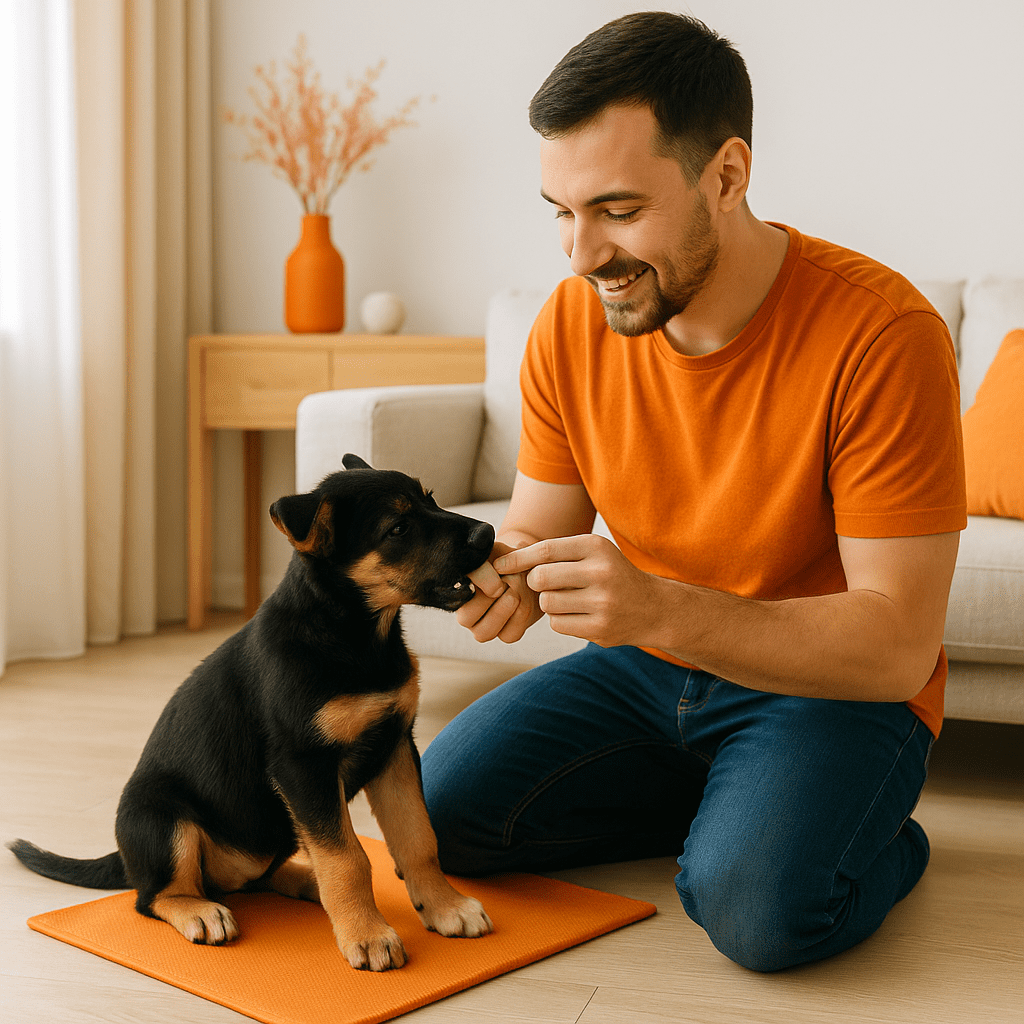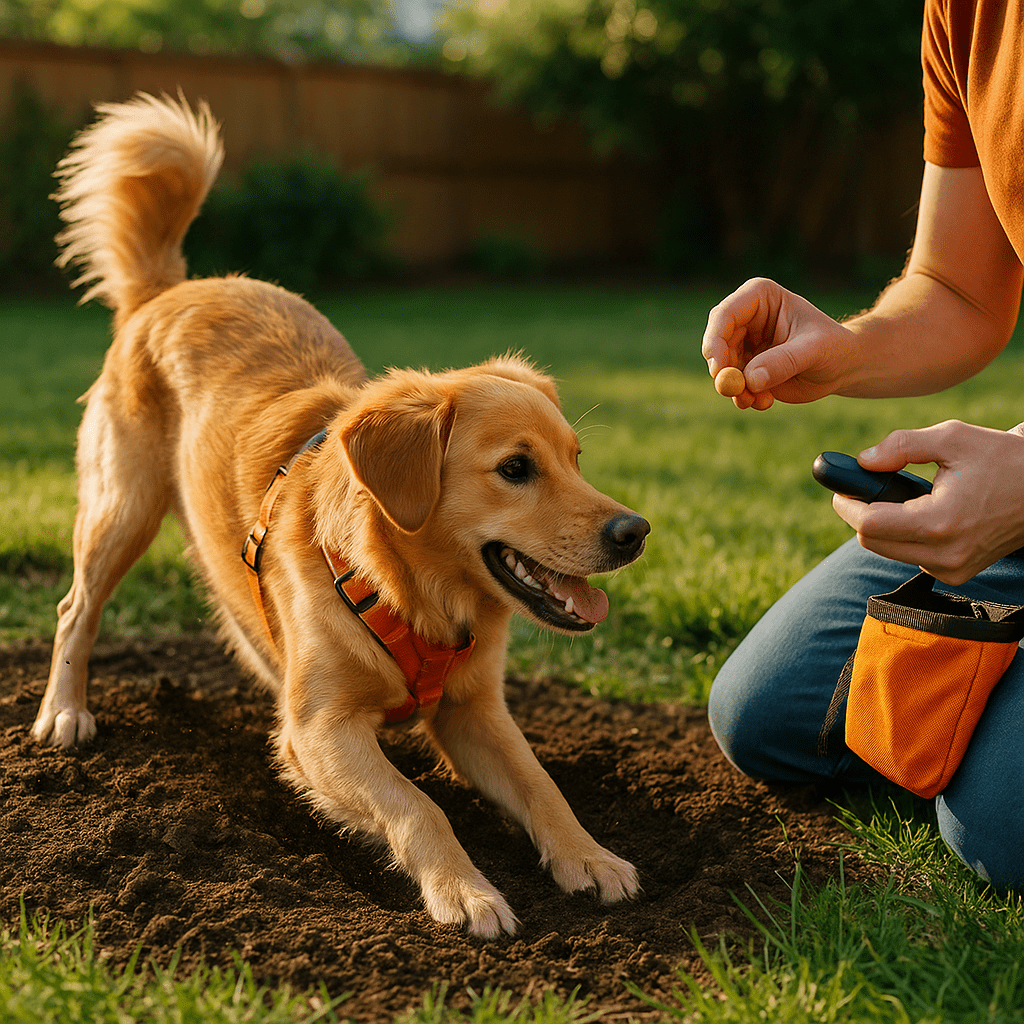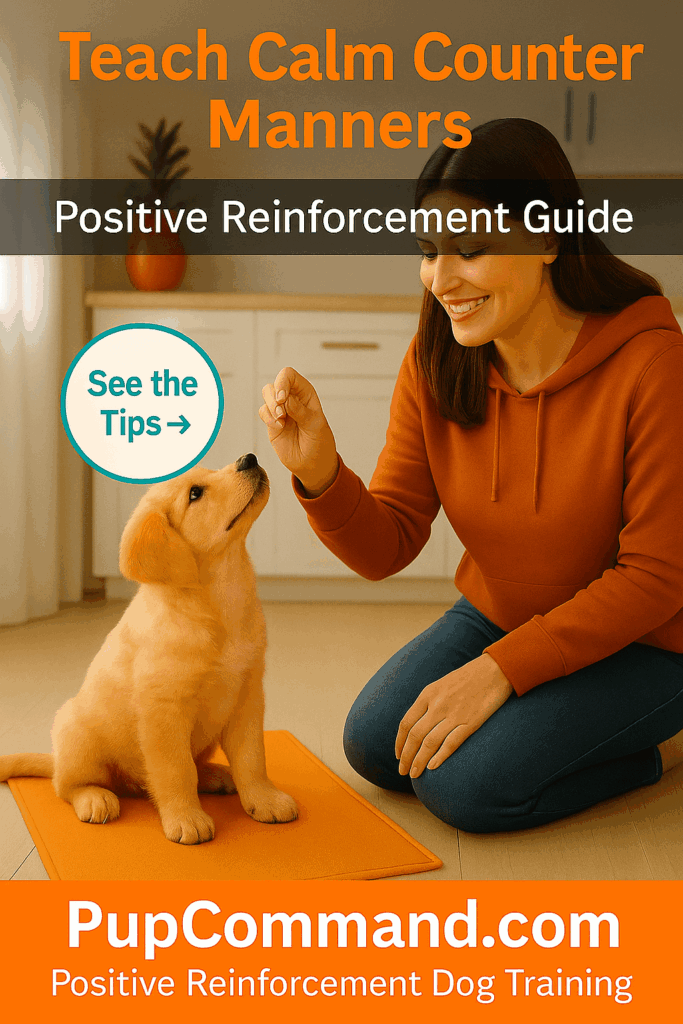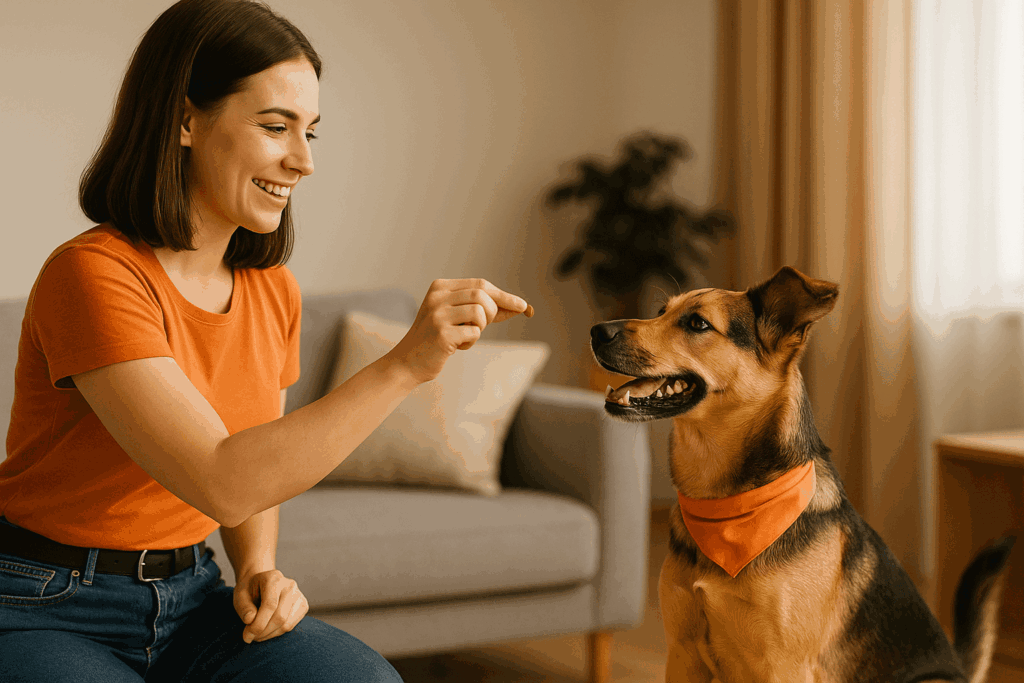How to Use Positive Reinforcement for Problem Behaviors in Dogs
How to Stop Darking at the Door Using Positive Reinforcement
(Without Yelling or Startling Your Dog)
Mastering positive reinforcement for problem behaviors is simpler than you think.
Few moments feel more chaotic than your dog frantically barking the second someone knocks or rings the bell. That pounding sound sends your pup into high alert—teeth bared, tail wagging anxiously.
With positive reinforcement, you can rewrite this script, teaching your dog that calm focus is far more rewarding than noise.
📦 Crate Training Blueprint: Raise a Calm, Confident Puppy
Struggling with barking, reactivity, or nighttime chaos? The root cause often starts in the home environment. This $7 PDF kit gives you the science-based, emotionally attuned strategy to build calm—one crate session at a time.
👉 Download the Crate Training Blueprint1. Establish a “Calm-Spot” Routine
- Choose a dedicated spot. Pick a mat, bed, or rug a few feet from the door—somewhere your dog can settle.
- Introduce the cue. Use a simple word like “Place” or “Mat” during quiet moments, luring your dog onto it with a treat.
- Create a positive association. Let your dog explore and rest there freely at first, rewarding any relaxed posture.
2. Reward the First Moment of Quiet
- Practice with a helper. Have someone ring the doorbell or knock lightly while you’re nearby.
- Watch for eye contact. The instant your dog breaks focus from the door and looks at you, say your marker word (“Yes!”) in a bright tone.
- Deliver a high-value treat. A small piece of cheese or soft training bite makes that brief pause incredibly rewarding.
- Repeat low-pressure drills. Run multiple short sessions—3–5 repetitions—so your dog learns “quiet after the bell equals treats.”
3. Build Duration and Introduce Mild Distractions
- Increase wait time. Once your dog reliably pauses for a second, gradually stretch to 3–4 seconds, then 5–6. Each extra moment of silence earns a treat.
- Reset calmly on mistakes. If barking starts, gently guide your dog back to “Place,” close the door, and reward the next tiny pause.
- Add controlled distractions. Use door knocks, creaky hinge sounds, or a low-volume radio to teach your dog that silence is still rewarded even when sounds vary.
4. Transition to Real-Life Arrivals
- Cue “Place” before guests arrive. Ask your dog to go to their mat as soon as the buzzer or bell rings.
- Maintain “Stay” until the door opens. If they hold quiet for 3–5 seconds, open the door and reinforce with lavish praise (“Good calm dog!”) and a treat.
- Involve visitors in the process. Ask friends to toss a treat from inside as the door opens so your dog learns even guests expect calm behavior.
- Be consistent. Practice this every time someone enters—brows hit a plateau without repetition.
By rewarding those early, quiet moments, you teach your dog that barking only delays the reward.
Over a few weeks of consistent sessions—ideally 5–10 minutes daily—the frantic barking at the doorbells fades away. Soon, your pup will greet every knock with poised attention instead of noisy chaos.
Positive Reinforcement for Jumping Dogs: Teaching ‘Four on the Floor’

Few things are more heartwarming than a wagging tail—but enthusiastic jumping can quickly turn hugs into accidental scratches. With positive reinforcement for dog training, you can replace those airborne greetings with polite paw-on-the-floor welcomes.
Teaching “Four on the Floor” not only curbs jumping—it strengthens your bond and boosts confidence.
1. Set Your Dog Up for Success
- Choose a calm environment. Start in a quiet room with minimal distractions so your dog can focus.
- Have high-value treats on hand. Soft cheese bits or small training treats work best to capture attention.
- Mark the moment. Use a clear marker word (e.g., “Yes!”) to signal when your dog does exactly what you want.
- [Insert photo: Dog sitting calmly with paws on the floor]
2. Reinforce All-Four-Paws Behaviors
- Ignore the jump. When your dog leaps up, step back or turn away—no scolding, no eye contact. This withdrawal removes attention, which dogs often seek through jumping.
- Wait for paws-down. The instant all four paws touch the floor—whether your dog’s sitting or simply standing—mark with your cue (“Yes!”) and reward immediately.
- Repeat “sit” or “down.” If needed, prompt “sit” as your dog’s feet land. Each sit earns lavish praise and a treat.
- Break sessions into short bursts. Five 2–3 minute reps per day keep your dog eager without overloading.
3. Add Real-Life Scenarios and Cues
- Practice at the door. Have a friend knock or ring the bell. When your dog approaches, ignore any jump; as soon as paws drop, cue “Four on the Floor,” mark, and treat.
- Use a verbal release. Once your dog stays with paws down for 2–3 seconds, say “Okay!” and allow a friendly greeting. This teaches patience and polite interaction.
- Gradually phase out treats. After consistent success, reward with affection or a favorite toy instead of food—maintaining motivation.
4. Celebrate Small Wins and Stay Consistent
- Track progress. Note the length of time your dog remains paws-down before giving the release cue. Celebrate even incremental gains.
- Involve visitors. Ask friends and family to follow the same routine: ignore jumping, reward four-on-the-floor. Consistency from all handlers speeds learning.
- Reinforce daily. Short, positive sessions—especially before mealtimes or walks—cement the behavior.
By focusing on rewarding stable paws instead of punishing leaps, you teach your dog: “Calm greetings win the day.” In just a few weeks of consistent, positive reinforcement dog training, your pup will greet every arrival on solid ground—tail wagging, heart full, and all four paws firmly planted.
🚀 Progress Metric
Drill Success Criterion Notes Stationary handler 8/10 reps no jumps baseline Moving handler 6/10 reps add clapping Doorbell + guest 3/5 trials maintain 4-sec hold
4. Generalise Across Environments
- Front porch ➜ backyard gate ➜ park trailhead.
- Use longer lead; mark & reward down low every third greeting.
- Fade food: swap in positive reinforcement dog training variable—praise first, treat second.
5. Emergency Abort Command
If launch sequence (jump) initiates: pivot sideways, fold arms, avert gaze. Zero reinforcement, zero scolding—just a calm reset.
Finish every session by praising the calm sit—your dog just nailed positive reinforcement for problem behaviors.
Nipping and Mouthing? Train Bite Inhibition

Few puppy behaviors spark more panic than sharp little teeth sinking into fingers or ankles. It’s natural for pups to explore with their mouths, but uncontrolled nipping can quickly become painful.
Teaching bite inhibition—your puppy’s ability to regulate the force of their bite—builds lifelong trust and keeps hands safe. With consistent positive reinforcement, you’ll transform those playful nips into gentle mouthing.
1. Recognize the Root of Nips
- Puppies learn through play. Young dogs investigate the world by chewing on soft toys—and your hands become their first “toy.”
- Teething discomfort. Just like human babies, puppies experience sore gums and seek relief by gnawing.
- Overstimulation. Excitement often ramps up during tugging or roughhousing, triggering harder bites.
- [Insert photo: Puppy gently chewing a soft toy]
2. Establish Consistent Boundaries
- Say “Ouch!” and freeze. When your puppy nips too hard, let out a high-pitched “Ouch!” or yelp. This mimics how siblings react, signaling that the bite was painful.
- Stop play immediately. Freeze—no pulling away or scolding. Pausing fun teaches: “Biting too hard ends the game.”
- Wait for a gentle lick or nose tap. The moment your pup touches you without teeth, praise with “Yes!” and offer a small treat. This reinforces soft contact.
3. Redirect to Appropriate Chew Toys
- Offer alternatives. As soon as puppy mouths, guide them to a sturdy chew toy or teething ring. Praise abundantly when they latch onto the toy instead of your hand.
- Rotate toys for novelty. Keep at least two or three textures—rubber, rope, and knotted cotton—to satisfy teething urges and prevent boredom.
- Praise gentle play. During tug games, pause anytime teeth graze skin and resume only when pups mouth the toy correctly. Reward calm, controlled tugging.
4. Build Bite Inhibition Through Structured Games
- Hand-feeding with caution. Use flat palm to deliver kibble. If puppy teeth down too hard, let food drop and wait for a soft mouth. This teaches restraint before every meal.
- “Give” and “Leave it” cues. Practice dropping treats on the floor; if puppy lunges for your hand, close your fist—only open when they back off. Reinforce “Leave it” before reward.
- Short, frequent sessions. Five-minute drills—three times a day—keep learning focused and avoid overstimulation.
By consistently rewarding gentle mouthing and withdrawing attention at every painful nip, you teach your puppy: “Soft mouths get all the love.”
Within a few weeks of positive reinforcement dog training, that sharp bite transforms into cautious, caring behavior—allowing you to cuddle without fear and enjoy a lifelong bond built on trust.
How to Stop Counter Surfing with Reward-Based Training

Few moments strike fear into pet parents more than turning your back for just a second—only to find prized leftovers vanished from the countertop.
Counter surfing not only ruins your dinner plans but can also be dangerous if your dog ingests something toxic.
Reward-based training offers a compassionate, science-backed way to redirect that temptation. By reinforcing alternative behaviors and making counters “boring,” you’ll teach your pup to keep all four paws firmly on the floor.
1. Identify Motivations and Manage the Environment
- Remove immediate temptations. Store food out of reach in sealed containers or the refrigerator.
- Use management tools. Baby gates or closed doors limit kitchen access during meal prep or eating.
- Observe patterns. Does Fido leap when you leave a plate unattended? Note times of day or specific foods that trigger counter surfing.
- [Insert photo: Dog eyeing food on a counter, with owner calmly standing by]
2. Teach an Alternative Behavior: “Place” or “Mat”
- Choose a comfort zone. Set up a “Place” mat away from countertops—ideally in a quiet, low-traffic spot.
- Lure and reward. Encourage your dog onto the mat with a treat. As soon as all four paws land, say “Yes!” and reward.
- Gradually add duration. Once your pup stays on the mat for 5 seconds, slowly build to 15–20 seconds before rewarding.
- Introduce a release cue. After a successful “Place” session, say “Okay!” so your dog knows when they can leave.
3. Associate Counters with “Nothing Happening”
- Practice in short drills. With your dog on “Place,” set a dummy plate on the counter (empty or with low-value treats). Let them watch. If your dog stays on the mat without moving, mark (“Yes!”) and reward.
- Increase temptation level slowly. Swap the empty plate for something mildly tasty (e.g., plain bread). Reward only if they remain calm. Over days, build up to more tempting foods.
- Reinforce checking in. If your dog glances toward you instead of lunging for food, mark that eye contact and reward.
4. Generalize to Real-Life Scenarios
- Practice during meal prep. As you cook, ask your dog to “Place” on the mat. Any attempt to break position means calmly resetting them to “Place” without shouting.
- Involve household members. Everyone must follow the same protocol: no scolding, just gentle resets and rewards on the mat. Consistency prevents confusion.
- Reward sporadically. Once your dog reliably ignores countertops for 30–60 seconds, switch to random rewards—sometimes treats, sometimes praise or a short play break.
By teaching a clear alternative and making counters uninteresting, you send one message: “Good things happen on the mat, not on the kitchen island.”
Within a couple of weeks of focused practice—short sessions, multiple times per day—your dog will learn that counter surfing only delays rewards, while “Place” means praise, treats, and freedom. Soon, your countertops will be safe zones again.
How to Redirect Dog Digging with Positive Reinforcement

Few behaviors feel as frustrating as rushing outside to find your flowerbeds turned into craters. Beneath every well-intended dig often lies boredom, pent-up energy, or natural instincts searching for a cool resting spot.
Redirecting dog digging with positive reinforcement for problem behaviors teaches your pup where it’s okay to dig—and keeps your garden intact.
1. Understand the “Why” Behind the Dig
Grab a chew toy and practice positive reinforcement for problem behaviors in short bursts. |
- Instinctual behavior. Many dogs dig to create a cool “den” on hot days or to bury treasured toys.
- Boredom and excess energy. A dog with pent-up energy will often dig simply to pass time.
- Attention-seeking. If every dig earns a reprimand, your dog learns that digging, even when scolded, still secures your focus.
2. Create a Designated Dig Zone
🐶 Learn the Full Power of Positive Reinforcement
Ready to transform your dog’s behavior with kindness, science, and clarity? Visit our complete guide to Positive Reinforcement Dog Training for beginners.
Go to the Full Positive Reinforcement Guide →- Choose a specific area. Use a sandbox, corner of the yard, or a low-value soil patch to be your pup’s “dig zone.”
- Bury enticing items. Hide favorite toys or safe treats just beneath the surface to spark curiosity.
- Encourage exploration. When your dog noses or paws in the designated spot, mark “Yes!” and reward with a treat or praise.
3. Teach “Dig Here” vs. “Leave It” for Forbidden Spots
- Use clear verbal cues. As soon as you see your dog approaching off-limits soil, say “Leave it.” If they stop, mark and reward immediately.
- Redirect to the “Dig Zone.” Lead your dog by leash to the designated area, then encourage digging by tossing a treat into the sand.
- Reward successful redirection. Once your dog digs in the correct spot, shower them with high-value treats and affection—reinforcing that digging here wins big.
4. Provide Sufficient Exercise and Mental Stimulation
- Daily walks and play sessions. A tired dog is less likely to dig out of boredom. Aim for at least 30 minutes of brisk activity, twice a day.
- Interactive puzzle toys. Mental challenges (snuffle mats, treat-dispensing balls) keep your dog engaged indoors and reduce digging urges.
5. Be Consistent and Patient
- Short, frequent training drills. Spend 5–10 minutes daily reinforcing “Dig Zone” behavior—consistency beats marathon sessions.
- Involve all family members. Every household member must follow the same redirection process; mixed messages stall progress.
- Gradually fade treats. Once your dog reliably digs in the designated spot, shift to occasional praise or a favorite toy as the reward.
By rewarding your dog’s natural digging instincts in an approved area and redirecting forbidden digs with a consistent “Leave it” cue, you teach: “Dig here for fun, not over there.”
In a few weeks of positive reinforcement dog training, those unwanted holes will vanish—and your pup will happily cavort in a space you both love.
Consistency turns positive reinforcement for problem behaviors into new, reliable habits.

Positive Reinforcement Counter-Conditioning Desensitization Shaping Classical Conditioning

